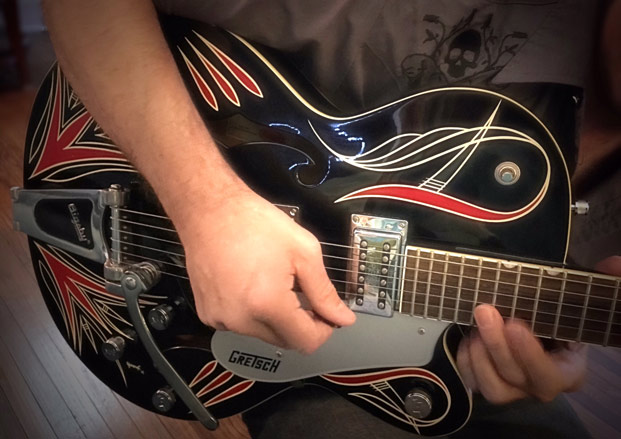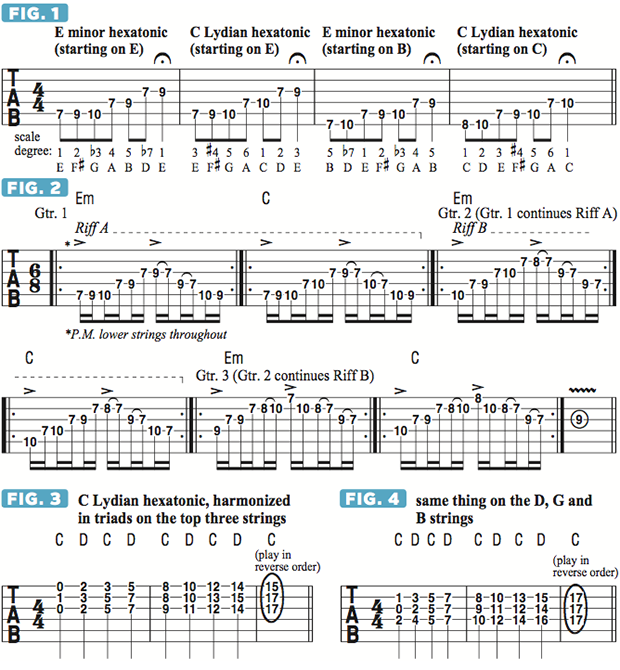The Intriguingly Exotic Sound of the C Lydian Hexatonic Scale

In two older String Theory columns (March and April 2015 issues), I introduced a pair of hexatonic (six-note) scales that are comprised of the same six notes and may be thought of as opposing sides of the same musical coin—the dark, serious-sounding E minor hexatonic (E F# G A B D) and its one useful mode, the beautifully bright D major hexatonic (D E F# G A B).
I’d now like to turn you onto another interesting and appealing hexatonic scale that shares five of these scales’ six notes, C Lydian hexatonic.
C Lydian hexatonic is formed by taking E minor hexatonic and raising the fifth, B, one half step, to C, and reorienting all the notes to a C root: C D E F# G A.
FIGURE 1 illustrates this metamorphosis and the close relationship between the two scales’ fingerings in seventh position, with each note’s function indicated, relative to the E and C roots. As you can hear, changing just one note creates an intriguing shift in musical color, with E minor hexatonic’s dark, pensive quality giving way to a bittersweet, longing feel with C Lydian hexatonic.
The sound of this figure implys a dramatic, circular Em-to-C progression, which brings to mind the intro and outro to the Pink Floyd song “Pigs (Three Different Ones),” as well as the chorus and solo sections of Led Zeppelin’s guitar tour de force, “Achilles Last Stand” and their extended live version of “Dazed and Confused” featured on The Song Remains the Same, specifically the slow jam before Jimmy Page’s violin-bow interlude.
FIGURE 2 is a hypnotic, keyboard-like line in 6/8 meter inspired by all three aforementioned compositions and based on the same Em-C vamp. It starts off with a looping single-note melody then proceeds to “stack” harmony leads upon it, using the same rolling sextuplet rhythm, beginning on E, the root of Em, then G, the minor third, then B, the fifth. Each time it switches to C Lydian hexatonic—in bars 2, 4 and 6—E becomes the third, G becomes the fifth and B moves up a half step to C, the root.
For further study, try playing the same notes in different positions and octaves, using the various E minor hexatonic fretboard patterns I presented in the March 2015 issue as a guide. Every time you switch to C Lydian hexatonic, move every B note up one fret to C. (To create more of an Iron Maiden–style harmony-leads figure, try omitting the two highest pitches in each repeating sequence and play the remaining eight lower notes as two beats of 16ths in 4/4 meter.)
All the latest guitar news, interviews, lessons, reviews, deals and more, direct to your inbox!
Another helpful way to think of C Lydian hexatonic is C and D major triads combined: C E G + D F# A = C D E F# G A. FIGURES 3 and 4 show inversions of these two triads “leapfrogging” each other up the neck on trios of adjacent strings. As with the Em and D triads we looked at in the previous two columns, these figures can serve as highly useful references for building harmony leads.
C Lydian hexatonic may also be conveniently reckoned as the C Lydian mode (C D E F# G A B) minus the seventh, B. The advantage of using C Lydian hexatonic instead of C Lydian is that its sparser architecture gives you a more “open,” pentatonic-like sound while retaining C Lydian’s signature note—the raised, or “sharped,” fourth, F#. And, as we saw in FIGURE 2, with an even number of notes, the hexatonic scale works well with 16th-note and sextuplet phrasing. Try using it with wailing string bends and legato articulations to get a soulful, Gilmour-meets-Page lead sound, as demonstrated in FIGURE 5.

Over the past 30 years, Jimmy Brown has built a reputation as one of the world's finest music educators, through his work as a transcriber and Senior Music Editor for Guitar World magazine and Lessons Editor for its sister publication, Guitar Player. In addition to these roles, Jimmy is also a busy working musician, performing regularly in the greater New York City area. Jimmy earned a Bachelor of Music degree in Jazz Studies and Performance and Music Management from William Paterson University in 1989. He is also an experienced private guitar teacher and an accomplished writer.

